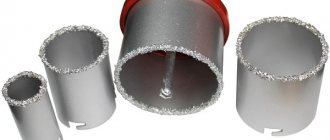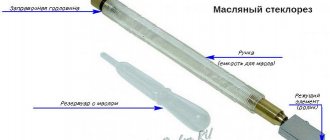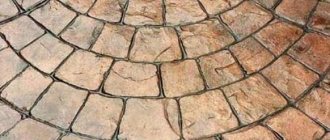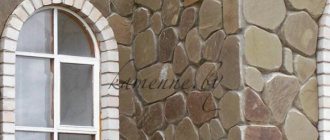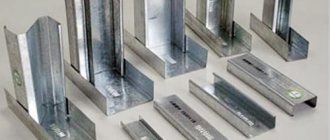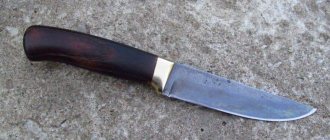How to drill a hole in a ceramic sink
When does the question arise? Sinks without a hole were installed in Soviet bathrooms where there was one faucet for the sink and bathtub. Recently, this option has been used less and less, but sometimes, during budget renovations, apartment owners want to save on buying a new sink.
Sink without tap hole.
And so, you have a sink that has no hole. Working with ceramic sinks may seem like a lot of work, but you can do it if you follow the tips below. It's simple.
You will need:
1. Drill or hammer drill. 2. Drill (feather) for ceramics. 3. Crown for ceramics with tungsten carbide coating
Step-by-step instruction
- To prevent the drill from moving, cover the area where you will drill with masking tape.
- We make markings - put a dot with a marker.
- Insert a ceramic drill bit into the drill and start drilling at low speed. Proceed with caution - ceramics are a very fragile material.
- Use a smaller diameter drill first - for example, 6 mm. Then replace it with 8 mm. It is important to constantly cool the drilling site - water it with cold water.
- After drilling the narrow central hole, switch to a bit with a diameter of 30 or 32 mm, depending on the diameter of the mixer.
- Every 2-3 mm, take a thin drill and make small holes in the circle that the crown made. This is done so that the teeth of the crown can engage the edges of the circle and continue working.
- When the hole is ready, you can install the sink in place.
How to drill a hole in artificial stone
Typically, sinks made of artificial stone come with an existing hole for the faucet, but there are options without it, or you need to drill an additional hole for the faucet for the water filter. What to do in such cases?
You can seek professional help, but if you feel confident, you can try drilling the hole yourself. But to do this, it is necessary to determine the material of the product - this determines which tool to use.
- Porcelain tiles
- Agglomerate
- Acrylic stone
Porcelain tiles
The strongest and most durable of the entire group is porcelain stoneware. It serves for a long time and is durable, tolerates temperature and chemical influences well, so it is in great demand. But it is also the most complex material; it is most difficult to make a hole in it than in other types of artificial stone.
The best option for carrying out the work is to choose a crown for porcelain stoneware. It can be supplied as a set with or without a centering drill.
When working with porcelain stoneware, the drilling site should be constantly cooled, and the drill speed should be at the lowest possible speed.
You need to understand which side to drill from and when. If from the front side, after installation, the edges of the hole will be smooth and neat, but there is a danger that the drill will slip and spoil the appearance, for example, scratch or damage the edge.
If from the back, before installation, you are unlikely to damage the bowl, but perhaps the hole will have uneven edges. Basically it's not a big deal because they will be covered by the faucet.
Remember - the further the hole is from the edge of the product, the better. Don’t forget about the bowl so as not to get another, completely unnecessary hole - porcelain stoneware is both a durable and very fragile material. Therefore, the following rules must be observed:
- Before carrying out the process, fix the sink, put chipboard under the bottom, this will protect the work surface.
- Drill exactly perpendicularly, otherwise the drill may damage the glaze.
- To prevent the drill from moving, cover the area where you will drill with masking tape.
- Before work, wet the drill; while drilling, spray the work area with water, for example, from a plastic bottle.
Agglomerate
Milling cutter for working with artificial stone
Agglomerate is a softer material. Usually the sink already has a hole almost drilled. It must be knocked out with a core or drilled with the cutter included with the sink. If the kit does not include a cutter or core, then it is necessary to perform the work with a diamond-coated crown. The instructions are completely identical to the process of drilling porcelain tiles.
Acrylic
The third option is acrylic.
If your sink and countertop have color cohesion and create a cohesive space, then it's acrylic stone. This option is not difficult to work with. Ordinary drills are suitable for working with metal or wood. The diameter of the hole for the mixer is 32-35 mm. It can be drilled with a feather drill for working on wood products. The drill speed should be at medium or low speed. When working with acrylic stone, a lot of chips are formed, and a rather unpleasant odor appears from the plastic heated by the drill.
Standard mistakes: how to avoid them?
What you need to remember if you decide to drill out an artificial stone sink:
- you need to work strictly at low drill speeds;
- It is advisable to cool the drilling area;
When working with acrylic or quartz stone, it is advisable to use a protective mask or respirator. When drilling, a lot of chips are formed and an unpleasant odor is released. You need to work in a ventilated area. The temperature of the product should be room temperature. You cannot drill into cold artificial stone.
How to drill artificial stone? For acrylic, drills for woodworking are suitable; you can take drills for metal; for quartz stone you need harder ones, with diamond coating. You can drill with feather drills or a Forstner cutter.
For the tap hole you need a cutter with a diameter of 35 mm. But the hole size may be different. Be sure to check this before starting work. Information about the size must be indicated in the accompanying documents for the plumbing fixtures. The difference of a few millimeters can be covered with a decorative cover, which usually comes with the tap. But if it is larger, it will be noticeable, and if the diameter is too large, it will be impossible to install the faucet.
How to work with a stainless steel sink
Manufacturers often produce stainless steel sinks without the special opening required to install the faucet. As a rule, such sinks are made of durable steel. This sink is very difficult to drill with a regular drill. A diamond-coated crown is barely enough for one hole (after that it will only be scrapped).
We offer for your consideration several options for installing a hole for installing a faucet on a stainless steel sink, although these tips are universal and are suitable for sinks made of ordinary steel.
Option #1
To drill a hole in it, you need to use cobalt drills (or tungsten, but they are more expensive) and a cutter. A cutter, or punch, is a two-part tool. It consists of a die and a knife connected by a bolt.
Read also: How to refill a Shtil chainsaw
Before starting work, the sink must be turned upside down. Next, we follow the following procedure:
1. Mark the installation location of the mixer with a pencil or bright marker. 2. Make a small dent in the center of the circle so that the drill does not slip off. 3. Make an initial hole using a 5-6 mm drill, and increase it to 10 mm with a drill of the appropriate diameter. 4. Install the punch (notch) so that the part with a smaller diameter is where the mixer should be. Tighten the bolt until the cutter cuts a hole.
Option No. 2
The second option involves drilling holes only for flexible connections and mounting stud(s). You can use the mixer pressure plate as a template. This option will save you from buying a cutter. But, in any case, you cannot do without cobalt drills.
Option #3
Here's a video as an example:
Drilling a hole
We make a hole in the artificial stone sink using a drill step by step:
- To work, you will need a regular drill and a cutter with a diameter of 35 mm. As mentioned above, you need to place the sink on the back side and place a board and newspaper under it.
- Next, mark the location of the mixer so that you can make a hole on the right side and avoid accidentally making a mistake.
- To mark the center of the hole, you need to attach the nut from the mixer and mark its center. Try to keep the hole further away from the edges without touching the bowl.
- Before starting work, make sure that the hammer on the drill is turned off. Begin to work carefully with the drill at medium speeds, avoiding allowing the cutter to move.
- Prepare a small box for the shavings that are generated in sufficient quantities during the process. Passing through the plastic, the cutter heats it up and it emits an unpleasant odor.
- When you finish drilling, clean the resulting hole from dust and chips. The size of the irregularities on the edge will not exceed a couple of millimeters: but they will not be visible under the mixer.
Punching a hole in the sink
Some artificial stone sinks have cast plugs that are knocked out during installation. They are usually color coded on the front. First of all, the sink is installed in place in the countertop, but is not fixed.
Then you need to choose the right tool and beat off the plugs with a strong blow with a hammer. A punch with a diameter of 8 mm is suitable for this role, but not a screwdriver. You only need to knock out the cork from the top: that is, from the front side. Use a rasp to smooth out the uneven edges of the hole.
Using this method, you can make a hole for the mixer.
- The center is outlined and the circle is drawn.
- Using a drill, holes are drilled along the circumference, the distance between which is 4 mm.
- To prevent cracks from appearing when knocked out, firmly fix the sink.
If there is a need to increase the radius of the hole, you need to draw another circle of the required size. All cuts are made from the same front side along the circumference at a distance of 4 mm. Using a punch or chisel, remove unnecessary parts.
> How to drill a hole in a granite sink
How and with what to drill cast marble
Products made from cast marble have high performance characteristics. They are durable, can withstand mechanical loads, and are not afraid of temperature changes. In the process of drilling holes, you must follow certain rules and know the operating technology.
How and with what to drill marble
How to drill cast marble? Diamond drills are the best option. They are hard, highly durable, and do not require constant cooling with water or regular sharpening. Only with their help can you get a perfectly smooth hole and not damage the solidity of the stone. Drilling is performed with speed calculation based on the diameter of the tool. The larger the drill size, the lower the rotation speed. Be sure to mark the future hole. To do this, you can use masking tape and a pencil.
Features, difficulties and basic rules
Beautiful washbasins made of composite materials differ from their ceramic counterparts in a number of positive qualities: For high-quality work, it is necessary to firmly fix the slab. It is recommended to drill from the back of the product to avoid small irregularities. Periodically dip the diamond drill bit in cold water to prevent overheating. Beginners often ruin polishing by pressing the crown vertically. It is necessary to start working at an acute angle, and only after forming a small hole, move to a vertical position. Drilling of cast marble is carried out without pressure on the drill. Since marble is not homogeneous, the risk of getting a crack or small chip is high. If you have no experience with a drill, start with low speeds and gradually increase them.
What tools will you need?
To drill a hole in marble, you need to prepare a drill, a drill bit (preferably a diamond one) and a marking pencil. Consider how to securely secure the stove, if it is not a pre-installed product. If possible, have someone press it firmly onto a flat surface. This will reduce vibration from the drill and help you get the job done faster.
Drilling technology
So, how to drill cast marble? It is recommended to adhere to the following instructions:
- fix the plate on a flat surface;
- mark the hole on the back of the product;
- drill a small groove at an acute angle;
- continue drilling with the drill positioned vertically;
By choosing the right drill and adhering to the basic rules, even a beginner can cope with drilling a hole in cast marble. Remember that you can always turn to professionals.
How to drill a porcelain stoneware sink
Among the above materials, porcelain stoneware is the most durable. Plus, this component is quite resistant to chemical and temperature influences and can easily withstand mechanical stress. Its distinctive feature is its ringing sound, which indicates the minimal presence of artificial additives.
The downside of such strength is the difficulty of processing porcelain stoneware, and it will be unrealistic to make a hole in such a sink with a regular drill. That is why in this case it will be possible to drill a hole using cutting tools (mills, drills, crowns) equipped with hard alloy tips (for example, diamond).
When working with such a tool, you should be very careful and not allow it to overheat, for which it is recommended to cool the drills (crowns) with water (supplied to the drilling site in a thin stream) and drill at low speeds (not higher than 400 rpm).
A plastic bottle with a hole in the lid can serve as a device for continuous supply of cold water. By pressing on a bottle of water, the resulting stream flowing to the drilling site will cool the tool well. You can find out more about the technique of cutting porcelain stoneware in the following article.
The cutting tool must be kept in water at all times.
Features of artificial stone sinks
Not all sinks made of artificial stone have the same composition, due to the use of different materials and in different ratios during manufacturing. As a result, shells from different manufacturers differ in their properties and density. Most often on sale you can see sinks made of porcelain stoneware, acrylic stone, agglomerate and a number of their analogues.
Each of the materials has its own characteristics. Taking this into account, before carrying out work, you need to decide which drill to use to drill a sink made of artificial stone and purchase it in advance.
Porcelain stoneware sinks
Porcelain stoneware is the material that has the highest level of strength and durability among them. Chemicals, low and high temperatures cannot harm it, and it also withstands mechanical stress. A characteristic distinctive feature of the material is its ringing sound, reminiscent of glass.
Other types of artificial stone sound more muffled. This is due to the fact that during their manufacture plastic and other polymer-based components are added to their composition. Even taking into account the fact that making a hole in other materials is much easier than drilling a sink made of stone, in many cases they are preferred. Due to the increased density level, conventional drills are not a suitable option for this task.
For porcelain tiles, it is optimal to use only a crown or a carbide-tipped drill. It would be better if it were diamond. Sintered annular drills are also capable of coping with this task, but they are an order of magnitude more expensive, which is why they are preferred much less frequently and often in situations where an impressive amount of work has to be performed. When making holes in porcelain stoneware, due to its high strength, you need to periodically take breaks, during which you need to cool the drill and the working surface with water. When drilling this material, the power tool must be set to minimum speed (up to 300-400).
Sinter sinks
Making a hole in a sink made of this material is not so difficult, since most of the models produced by well-known manufacturers are mainly sold together with a cutter or center punch, with which you can cut out and knock out, respectively, a piece of stone that has already been partially subjected to drilling.
How to drill a sink from agglomerate
The second most durable material for making kitchen sinks is fragranite (silgranite), which is why it will be somewhat easier to prepare a hole in this element. In addition, many brands offer the user to simply knock out the required hole using a metal rod (8mm in diameter). Why are areas with prepared recesses provided in the product? This is done so that the user can independently choose the location of the mixer depending on the right or left position of the wing.
If you are not ready to use the proposed method (there is a possibility of chipping), then again you can use a diamond-coated cutter (crown) and make a hole according to the algorithm described above.
A more affordable option would be to use a Fostner cutter, which will also cope with the task. However, after a couple of such drillings, the cutter will not be suitable for subsequent use.
Often, agglomerate sinks provide places for knocking out holes, but despite this, many consumers complain that they cannot knock out a hole without problems. Since a visible chip may form on the front of the sink. To prevent this from happening, you should carefully study the instructions for installing the plumbing fixture, and only after that begin the work.
If we consider the manufacturer’s recommendations, then to punch holes in the product, you should use a metal core with a diameter of about 8 mm and strike at a strictly marked point on the front side of the product (usually the places for installing the mixer are indicated by a sticker of a signal color - yellow, red or green). If you try to perform this operation from the back of the sink, there is a possibility of chipping.
Read also: DIY aquarium compressor
Well, in order not to carry out this work by weight, it is more justified to first install the sink in a given place, and only then, using a core and a hammer, make a hole in a strictly designated place.
Please note that the location of the proposed hole should have a cylindrical recess on the back of the sink.
When the hole is knocked out, it is recommended to trim it using a round file or sandpaper.
How to drill a sink from acrylic stone
Due to the fact that acrylic stone is the least durable among the listed materials, it is easiest to drill holes in it. And even an ordinary wood drill can cope with the task. However, given that the standard hole for installing a mixer should have a diameter of 35mm, it is still more justified to use a pen drill or a Faustner drill.
In this case, you should work at low speeds, but at the same time make sure that microcracks do not form in the material, which is why you should work with a well-sharpened tool and ensure a constant drilling force.
By the way, you can read about how to drill ceramic tiles.
For the convenience of users, we suggest that you watch the video instructions for drilling a granite sink.
How to repair an acrylic bathtub at home
How to make a table from a windowsill
How to make a concrete countertop with your own hands
How to cut drywall: various techniques
Popular publications:
Construction workSee what “Construction work” is in other dictionaries: Construction work - construction work,…
How to select and install a faucet on a sink: replacement procedureUse of water for domestic needs...
Decorative tile Loft brick, gypsum, beige color, 1.04 m2 If you want to get rid of hemorrhoids, then...
How to tighten plastic windows Plastic windows require periodic maintenance, and over time even…
It is sometimes difficult to distinguish artificial stone from natural stone by its appearance. And in terms of strength and resistance to external atmospheric influences, in some cases it can even exceed it.
Types of decorative stone: agglomerate, acrylic stone, porcelain stoneware, artificial concrete stone.
It is very important that the weight of such stone and its cost are significantly lower than that of natural stone.
These qualities largely determine its popularity for the exterior and interior decoration of houses and apartments. It is also used when laying garden paths, equipping bathrooms, making countertops and window sills. Therefore, many DIYers are interested in how to cut such a stone, if you need to change its size or shape, how and how to drill holes, for example, for water pipes.
Artificial stone, made using different technologies, has different hardness. It depends on what components were used as filler and binder material. All such types of stone can be divided into:
- agglomerate;
- acrylic stone;
- porcelain stoneware;
- artificial stone on a concrete base.
Diagram of the hammer drill device.
Agglomerates, which include large quartz, granite, marble or limestone chips, and sometimes whole pieces of stone, bound with polyester resins, can be stronger than natural samples. The composition of acrylic stone includes fine-grained filler (up to 70%) and acrylic resin. This distinguishes it from agglomerates and makes it plastic when heated. It can be scratched or scorched.
Porcelain stoneware products are superior in hardness to ceramics and glass, since their main component is highly compressed kaolin clay.
Stones made from sand and cement or Portland cement are similar in properties to ordinary concrete. In some cases, manufacturers replace white cement with gypsum. Such artificial stones are less hard, can be easily processed, are cheaper, but are relatively easily destroyed under the influence of moisture and low temperatures.
Drilling a sink made of artificial stone - detailed instructions
When purchasing a sink made of acrylic stone, the client often encounters a similar difficulty as the lack of a hole for the faucet. Of course, you should contact specialists, but this issue can be resolved without outside help.
In order to understand how to drill out a sink made of acrylic stone , you need to understand from the very beginning what it is made of. There is no clear definition of “acrylic stone”; therefore, various manufacturers use this term for different materials that differ in density and characteristics.
The most popular are:
- ceramic granite;
- stone agglomerate (fragranite, silgranite and their analogues);
- fake diamond.
When working with each of these materials there are specific specifics. To decide which drill to use to drill out a sink from acrylic stone, you need to understand from the very beginning what was actually purchased.
Porcelain stoneware countertops Porcelain stoneware is considered the most durable and durable of the materials listed above. It is not afraid of temperature and chemical influences, is resistant to impacts, scratches, and so on. It stands out due to its ringing “glass” sound. Other types of acrylic stone produce a duller sound due to the addition of plastic and polymer-based materials. Despite the fact that making a hole in other materials is easier than drilling a sink made of ceramic granite , quite often the choice of users falls on it. Taking into account the unusual density of the material, ordinary drills will be powerless here.
Only a crown or a carbide-tipped drill, preferably diamond, can handle ceramic granite. It will also be possible to work with sintered ring drills, but their price is much higher, so they are selected infrequently, only if there is a need for a significant amount of work. Due to its great strength, when working with such material it is necessary to cool the drill and the working surface with water. It is necessary to work with ceramic granite at very low speeds (300-400 no more).
How and with what you can make a hole
To process a material such as artificial stone, you can use the same tools as when working with concrete products. The tool used for drilling the hardest materials can be successfully used for drilling all its varieties. This is usually done with one of the following:
The grinder is used for drilling using special diamond bits, the design of which allows them to be used by screwing them onto a shaft to secure the disk. The crown is installed at right angles to the body of the angle grinder.
Drills or crowns are selected taking into account the size of the required hole and the hardness of the material used. As a rule, they have a carbide tip with pobedite tipped, diamond-coated or brazed diamond segments.
Clamps are used to secure the material. Dry drilling and water drilling are used to cool the cutting edge of the tool and the stone itself. In addition, water cleans the drill from sludge, and the edge of the drilled hole remains smoother. There is much less dust during wet drilling.
In order to drill with water at home, make a plasticine bath around the drilling site or place a rubber ring into which water is added. When using a template, water can be poured directly into it, sealing the cracks with ordinary tape. Sometimes water is simply added little by little from a plastic bottle.
Artificial stone can sometimes have a polished surface on which the marking lines are difficult to see. In this case, paper construction tape glued to its surface will help. The lines are clearly visible on it, even if you draw them with a pencil.
How and with what to drill stone
Many builders and just people are wondering how to drill stone, the answer is quite simple, this needs to be done using a special drill, at the end of which there are specially equipped soldering tips, the metal of which is very durable and stable.
Most often, this kind of drill is used very closely to drill concrete; it is an indispensable find on large construction sites, and in order to make the whole process easier and faster, a hammer drill is used for the drill, with which you do not have to use unnecessary physical effort , the hammer drill itself operates with the help of a strong impact force that acts on the drill rod.
All this can be explained by production technology. On the market today you can find a wide range of these products in different modifications, it all depends on the wishes of the customer, because manufacturers can produce the product in any version. In this case, such criteria as loads, scope of application, etc. are taken into account. Such welded metal beams https://bzmto.ru/prodaga-svarnoy-balki can perform the task of a support column, a span in structures, or be the supporting skeleton of a building. Thus, the design can be called universal and multifunctional without any problems.
In order to drill artificial stone, you need a hammer drill and special drills that are coated with diamond, this combination allows the tool not to heat up, but at the same time drill holes much faster and without delays, that is, the whole process goes very quickly.
Also, in order to drill a hole in artificial stone, you can use a diamond-coated drill in combination with a regular electronic drill, which is available in every owner’s arsenal. In order to make a hole in a small stone, you can use a specially made needle, which has a diamond tip, thanks to it you can make any decoration from the stone in a short time, and an equipped machine can be used as a tool.
In cases where a large diameter hole is needed, a crown is used, which, like a drill, has soldering on its end made of a very durable and hard metal alloy. If we talk about the scope of application of such a drill, then the main industry is construction, they make holes in large and thick load-bearing walls, such holes are most often needed to install a ventilation or plumbing pipeline, only with the help of a crown can you make a huge number of holes and This will not damage the wall around, which is very important, because in case of damage, additional puttying and plastering work will have to be done.
If we talk directly about drilling with a crown, then this should be done at the lowest possible speed, while the tips must be constantly watered with water, this is necessary if you do not want the crown to overheat, which can subsequently lead to breakage of the entire tool as a whole , and also to ensure that the service life of the crown is as long as possible.
How to drill concrete stone
How to drill artificial stone, namely the list of tools needed for this process:
- a drill that has carbide tips;
- a drill with a special diamond coating, which can have different sizes and diameters;
- a crown, which also has carbide tips, which can have different sizes and diameters;
- hammer drill or drill;
- needles that have diamond tips and come in a variety of sizes and diameters.
In order to make large holes in stones, it is advisable to have equipment that is designed specifically for this type of work; it is attached to a monolithic concrete wall, and this is done in order to make holes for communication pipes, and so that the crown remains The whole thing needs to be connected to hoses, through which water will continuously flow to its soldering.
You need to understand that in order to drill a stone, equipment is not enough, for this you also need to know a certain technology that is used in this process, and it lies in the fact that each stone has its own strength and hardness and must be used for processing and drilling various attachments, for example, in order to drill granite, which is very hard, but at the same time quite fragile, you need to select the right drill and decide how thick the hole should be and what depth, the principle is that the thicker the hole should be, the lower the tool speed , and the thinner they are, the faster they should be.
In order to make a hole exactly in the designated place, you need to tilt the drill to the side and make a groove, which in turn can direct the drill in the desired direction. If we talk about water in this process, then it serves not only to ensure that the soldering does not overheat, but also to ensure that all the debris that is formed from drilling is washed out and does not interfere with further penetration.
As for granite and other fragile stones, it is best to drill them with a drill rather than a hammer drill, since constant impacts can cause it to crack, which will be an unpleasant and unnecessary moment, because the cost of high-quality granite is not so low. After everything described above, the question of how to drill a stone, as well as what to drill a stone with, will fade into the background, because all the most important and necessary things were said in this article, it will be enough to just use these tips and do it as accurately as possible.
How to defeat porcelain tiles
For drilling porcelain stoneware, because it is very hard, use a drill with a special attachment.
Drilling porcelain stoneware is not easy; it is one of the hardest materials to process. To get smooth edges of the hole, you should always start from the front side. At the exit, the drill can make a chip, but in this case it will remain invisible. If the slab you are going to drill is not yet secured to the floor or wall, you should place a flat board or piece of fiberboard underneath it.
If the diameter of the proposed hole is more than 6-8 mm, you must first drill it with a tool with a smaller diameter. To work with porcelain stoneware, it is better to use a hammer drill or a fairly powerful drill.
Read also: Do-it-yourself grinding machine from a drill
The drilling speed is low or medium, it depends on the diameter of the drill. The larger the diameter, the lower the speed. It is better not to use a hammer; there is a risk of splitting the slab. In some cases, especially with a large thickness of material, a striker is used at low speeds if there are no voids under the slab, but everyone does this at their own peril and risk. When drilling, you must use water for cooling.
The best results are achieved when using diamond tools. In practice, different drills are used: carbide tips for tiles, a stylus with a diamond tip, diamond-coated tubes, and diamond bits.
Good results are obtained with thin-walled monolithic diamond-metal tubes made in China, and they are inexpensive, about a dollar per piece.
The drill wears less if you drill perpendicular to the plane of the material. To do this, a drill or hammer drill can be mounted on a vertical stand. In this case, the drill resource almost doubles.
It can be very difficult to start drilling with a crown on a smooth surface; it constantly tries to move to the side, scratching the surface. Therefore, to obtain a high-quality result, you can make a template in advance for holes of different diameters. The template is firmly clamped with clamps and prevents the crown from moving from the drilling point. You can also add water here for cooling.
You can start drilling at an angle to the plane if a template is not used: then the crown cuts into the stone with one side and then is leveled. But this method is better used on softer materials.
You can drill holes in stone using concrete and agglomerates in the same way.
How to make a hole in stone
Over the past six months, I have answered the question of how to make holes in stones probably a dozen times. I decided to systematize it a little and tell it again, in general terms - now without any individualism.
So.
There is a very simple method - ultrasound, but not everyone has the device, it makes a ringing noise, emits noise, is harmful and does not bring pleasure - however, it works wonders quickly and in capable hands. But we won’t even think about him, we’ll do it the old fashioned way 
In relatively soft and non-fragile stones - such as malachite, serpentine, lapis lazuli - you can make a hole simply with a good drill for metal - clamp the drill into a drill, put the stone in water - if possible, secure it - and go ahead. You can simply keep a wet sponge next to the hole - the main thing is that it does not overheat.
If the hole is through, be sure to place it on another stone, it is even better to glue it with wax or paraffin, or even double-sided tape. Otherwise there will be a chip at the exit.
With harder stones the story is more complicated. Here you will need a tubular, diamond-coated drill. They are sold in special stores, such as Sapphira, and in ordinary good hardware stores, and much cheaper. Their diameters range from 1-1.5 millimeters to 12-15, and more are quite rare and very specific. I have the most popular 2-2.5 mm.
I cut such drills right away - I cut off the shank a little - then the drill is clamped deeper and does not hit, and this is very important.
We take a stone, figure out why we need it, choose a place, put a mark, cover the bottom with a plaster and put it in a bowl of water. Two to three millimeters of water above the stone is enough. The adhesive will help the stone not to slide in the bowl and will at least protect it a little from chipping at the exit of the drill.
And we begin at low speeds, slowly but surely, pressing the drill in the right place. It is very important not to distort it. Every 15-20 seconds the drill should be lifted to remove debris from the hole. After a few minutes, a groove is formed - and the drill already receives direction.
The drill gets dull quite quickly, and doesn’t even get dull - it gets “greasy”, but this can be solved very simply - just put a piece of ordinary emery next to the stone and touch it with the drill from time to time.
When the drill goes a few millimeters deep into the stone, it is advisable to break the core column that has formed with a pin, a scriber, or a piece of iron and shake it out - then knocking it out of the drill is a little more difficult, although this is also not a problem.
When the hole tends to exit, you can start drilling from the other side, but this is only when increased demands are placed on the quality of the hole.
A little more and the drill will go easily - it means it has reached the surface, which is what we need.
That, by and large, is all.
In this case, a 4 mm cabochon was drilled in about a quarter of an hour, but this drill has already made dozens of holes in agates and flints, the new one works faster.
On paper (on the screen) everything is fast and easy, in reality it is a little more complicated, and not even more difficult - you need to be prepared for the fact that it will start to work out normally somewhere in the fifth or sixth.
I’d like to draw your attention to the following points: the drill is quite soft, its walls are thin, you need to clamp it into the chuck extremely gently. When you put the tip aside with the drill clamped so that it does not cling to anything, it bends instantly and practically does not straighten to its normal state. After work, be sure to immediately clean it from the inside, otherwise the sludge will dry out and there will be problems in the future. It is also better to drill soft stones with such drills - carefully and with dignity. You can also drill with a regular drill - it’s better to put it on its side, and constantly dip the pebble under the drill. And remember the rules for working with electrical appliances!
It seems that we can finish here about the holes 
And one of these days I’ll try to continue about this agate.
Features of working with acrylic and plaster
All methods mentioned above are suitable for working with any artificial stone. However, acrylic stone has a more plastic structure and allows the use of tools of less high hardness. Drilling into acrylic stone is more like working into hardwood or aluminum.
Therefore, it can be drilled using ordinary metal drills; even a wood spade drill or a Forstner cutter will do. Large holes are drilled using a crown or tubular drill. Can be drilled dry.
Artificial stone cast using gypsum as a binder also does not require the use of tools of increased hardness. Sometimes to work with it they use a regular hacksaw for metal, or even wood, a mounting knife, an abrasive mesh or sandpaper. You can drill it with a simple metal drill if there are few holes. But for clean work, it is better to use drills or crowns with carbide tips.
Drilling can be done using a cordless screwdriver, selecting drills of the required diameter.
You can easily process a hole using a hand-held wood router by changing the shape of the hole or its size.
How to give a slab the desired size and shape
At enterprises, artificial stone is cut on stone-cutting machines with coolant supplied to the cutting site, and laser or waterjet cutting is also performed. The last two methods allow you to give the stone the most amazing, even curvilinear shape.
At home, the choice is not so great. This problem can be solved using a hand-held circular saw or plunge-cut saw, selecting a blade that matches the material being cut. An electric tile cutter will also do the job well.
Electric tile cutters are equipped with a small coolant bath located under the cutting table. Based on their operating principle, there are two types of tile cutters. In one case, the disk is installed motionless, and its work table with a stone attached to it moves. In the other, the disk, together with the drive, moves along guides above the cutting plane.
All of these devices work with diamond blades of various configurations, solid and segmented.
If the relief and thickness of the stone tile allows, it can also be cut using a manual tile cutter.
But the most universal tool for cutting stone is considered to be a grinder with a diamond blade. It is advisable to choose a disk of large diameter. Different discs are available for different materials.
To cut cuts in stone, they sometimes use a jigsaw or a diamond string. There are also special stone blades for a regular hacksaw for metal.
In order to install the faucet in an artificial stone sink, it needs to be drilled. But drilling a hole in such a sink is not so easy; this requires special equipment. Let's talk today - how to drill a hole in a sink made of artificial stone.....
First, let me explain why you need to drill a hole. It's simple, many sinks made of artificial stone do not have a hole for the faucet, and you need to drill it to install this faucet. But it is not advisable to drill such a sink with a regular drill, you can simply damage it, and it is not cheap. In order to make a hole we need a special drill - called a Forstner drill.
Replacement for diamond tools
How to drill into granite if you don’t have a diamond-coated drill? In addition to a diamond drill, holes in granite can be made using pobedit drills, diamond dust or corundum. These tools are inferior in quality to a diamond drill and make the drilling process longer, but with their help you can achieve the desired result.
To make a hole in a granite slab using corundum, diamond dust or ground pobedite, you need a tube made of copper or brass and fixed in a drill. The diameter of the hole marked on the slab is protected by a side that is 4-5 mm high and made of plasticine or putty with quick-drying properties.
To work independently with granite stone, you must have the appropriate skills and tools, and perform the work carefully and accurately. To understand how to drill through granite without damaging it, it is recommended that you first practice drilling using scraps of granite.
I need advice from experts, I have a stone sink, I wanted to install a water filter on it... the question is how to drill a hole for the faucet without splitting the sink
Forstner drill
A kind of chisel, with pieces of “pobedit” (strong steel), both in the center and in a circle. This drill will be able to cut stone or artificial stone. And it crumbles it into small pieces. Read in detail in the article - WHAT IS A FORSTNER DRILL (click opens in a new window).
— Now we apply the mixer, which we will embed.
— We outline the mixer and determine the mounting location.
— Next, we determine the center for drilling.
— Install the forstner drill into the drill.
- We're drilling. Moreover, you need to drill slowly, not at high speeds. The main thing is not to damage the sink.
— After drilling, a smooth hole is obtained. You can install a mixer.
This way we get a smooth hole in the sink. I hope my article was useful to you. After we have made the hole, you can INSTALL THE MIXER, be sure to read.
